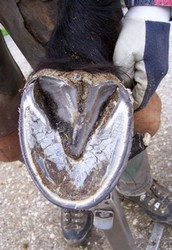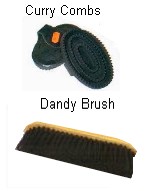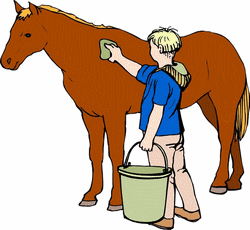by Adrianne Lake
Grooming the horse is important for a number of different reasons. It helps create a bond with the horse, and it allows you to become familiar with the horse’s body (especially the legs) and check for scrapes, swellings, or other injuries and skin disorders.
It is crucial to groom your horse before riding because any dirt or debris under the saddle and tack (especially the girth area) will irritate the animal when riding. Many horses love to be groomed and enjoy this special attention.
In this article, you will learn the basics of grooming a horse, from the equipment required to how you should use that equipment for best effect.
Ideally, grooming your horse or pony should be a pleasurable experience for you both. If you know what you are doing, you will relax and enjoy the experience and your horse or pony will respond in kind. To give you some practice, we’d like to introduce you to the Google Gadget Pony (at right). Gadget’s mane and tail are looking rather tangled, so why not pick up that brush and try some basic virtual grooming?
Basic Grooming Equipment:
You will need a hoof pick, plastic and rubber curry combs, a soft and stiff bristle brush, a finishing or body brush, a plastic mane and tail comb, and a sponge and bucket of warm water.
Cleaning Hooves
 The first thing one should do when the horse is in cross ties is pick out the feet. A trained horse should know how to lift its hooves for you when asked properly. Begin with your hand at the shoulder on a foreleg and glide your hand down to the fetlock. This should cue the horse to shift its weight off this leg. Grasp the fetlock and pull it upwards so that the knee is bent. You will need to be bent over. Hold the hoof firmly with one hand and pick the foot out with the other. Remove all the mud and stones taking care to pick out the groves beside the frog. (Be careful not to irritate the frog).
The first thing one should do when the horse is in cross ties is pick out the feet. A trained horse should know how to lift its hooves for you when asked properly. Begin with your hand at the shoulder on a foreleg and glide your hand down to the fetlock. This should cue the horse to shift its weight off this leg. Grasp the fetlock and pull it upwards so that the knee is bent. You will need to be bent over. Hold the hoof firmly with one hand and pick the foot out with the other. Remove all the mud and stones taking care to pick out the groves beside the frog. (Be careful not to irritate the frog).
The process is similar for the hind leg except you begin with your hand on the hindquarters and the leg will stretch out back behind the horse. It you have never picked out feet before it is wise to have someone knowledgeable help you the first few times. A tip I learned from Pat Parelli when having trouble picking up the hooves is that the “up button” for the forelegs is pinching the chestnut while pinching the hock is the “up button” for the hind legs. After the hooves are picked out, you may want to apply a hoof dressing (ie Rainmaker) especially if you will be riding in a sand ring.
Brushing Your Horse
When the hooves are clean it’s time to begin brushing. (If your horse has muddy legs, you may want to sponge it off with some warm water.) When groming, you begin at the top of the neck, then continue to the shoulder and back and barrel area, and finish with the hindquarters. Then do the other side of the horse.
 There are mainly two types of brushes: curry combs and stiff and/or soft bristled brushes. Curry combs are used first to remove caked on mud and loosen debris. They should not be used on the lower leg or head because these are sensitive areas. Types of curry combs include plasic and rubber, and should be used vigorously in a circular motion. Curry combing also promotes good circulation and most horses love it because it is a body massage. If you notice that your horse flinches or pulls away from you when currying, it may be a sign of pain or that you are currying too hard in a sensitive area. The currying is complete when all mud is removed.
There are mainly two types of brushes: curry combs and stiff and/or soft bristled brushes. Curry combs are used first to remove caked on mud and loosen debris. They should not be used on the lower leg or head because these are sensitive areas. Types of curry combs include plasic and rubber, and should be used vigorously in a circular motion. Curry combing also promotes good circulation and most horses love it because it is a body massage. If you notice that your horse flinches or pulls away from you when currying, it may be a sign of pain or that you are currying too hard in a sensitive area. The currying is complete when all mud is removed.
Next comes the bristled brushes. Start with the dandy brush. This is used to flick off the loosened dust. It is a swipe and flick motion. (Don’t forget to begin at the neck and finish with the hindquarters.) Make sure you don’t miss any part of the horse’s body, yet take care not to irritate the lower legs or head. Dandying is complete when all the dust and muck is flicked off and the horse is looking more polished.
Now is the time to use the body brush which completes the brushing process. This brush can be used on the head and lower legs as it is a gentle grooming tool. The body brush is the finishing touch and polishes the coat and removes the last dirt and dust. Take care when grooming the head and don’t poke your horse in the eye. Many horses are head shy and don’t like having their ears touched, while others love to have their head groomed. While grooming, use your hand to feel all over the horses body and it’s legs to become familiar with it’s anatomy. This helps in the future because if you are aware of your horse’s quirks and bumps, you will know when a new injury has occurred. Also be aware of any heat you may feel. Once this grooming process is complete you are ready to saddle up or do some ground work. When your horse is cooled out after exercise you should groom it again. Keep in mind not to groom a wet or sweaty horse.
Grooming the Mane and Tail:
Usually I just comb my fingers through my horse’s manes and tail but you can gently comb with wide-tooth plastic comb. Be careful not to pull out the hair if you want a nice thick tail. You could apply some conditioner like “Cowboy Magic” to help with the detangling. Show horses may have their manes and tails braided or the mane may be pulled short on an English horse.
A note about rolling:
Don’t be discouraged if your beautifully groomed horse rolls and becomes filthy. This is good for the horse because mud purifies the skin and removes toxins. Rolling is also a natural horse habit. So if you bring your horse in and it’s caked with muck and take the time to groom it properly the horse will actually be cleaner than it would if it hadn’t rolled.
